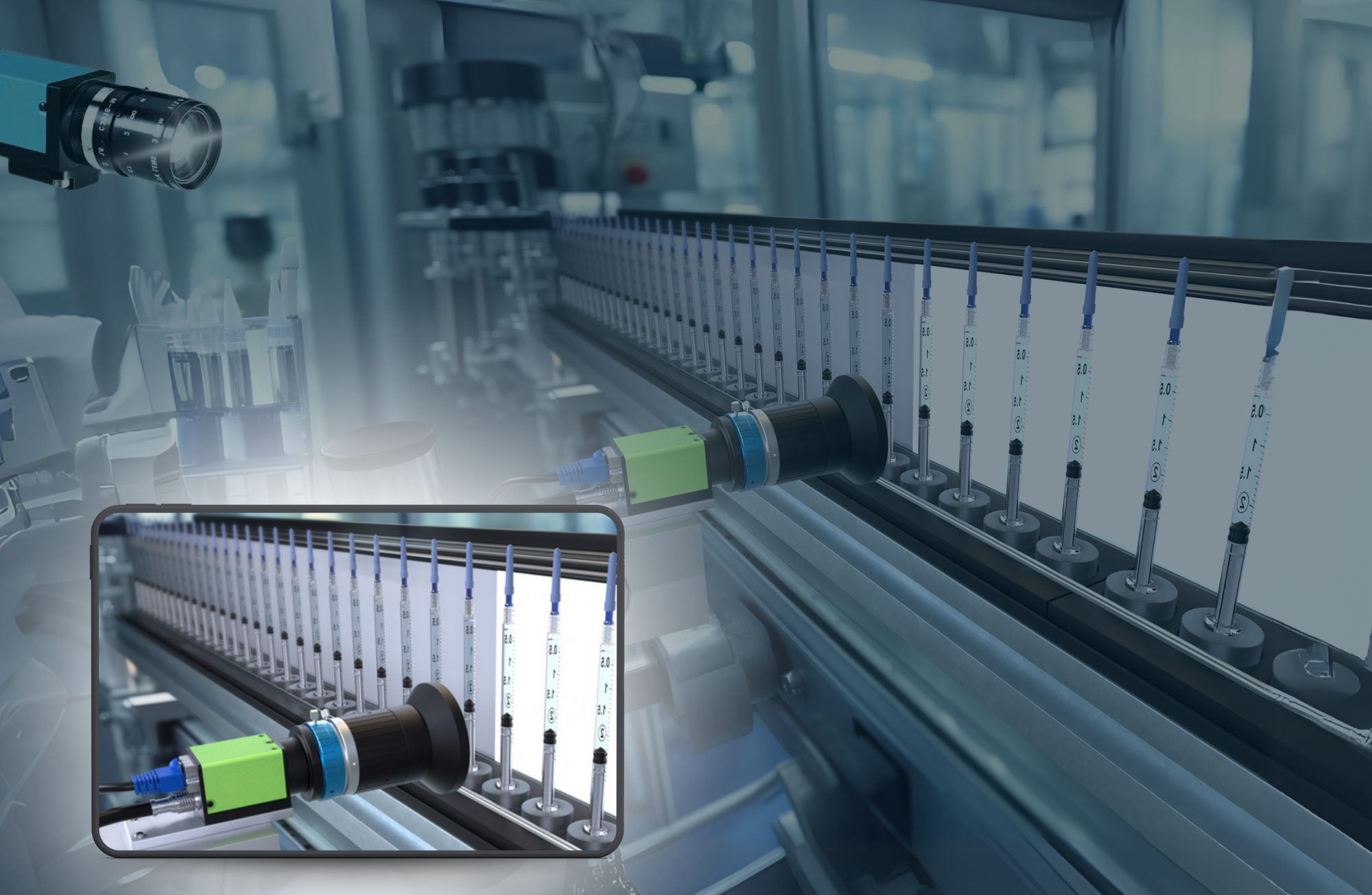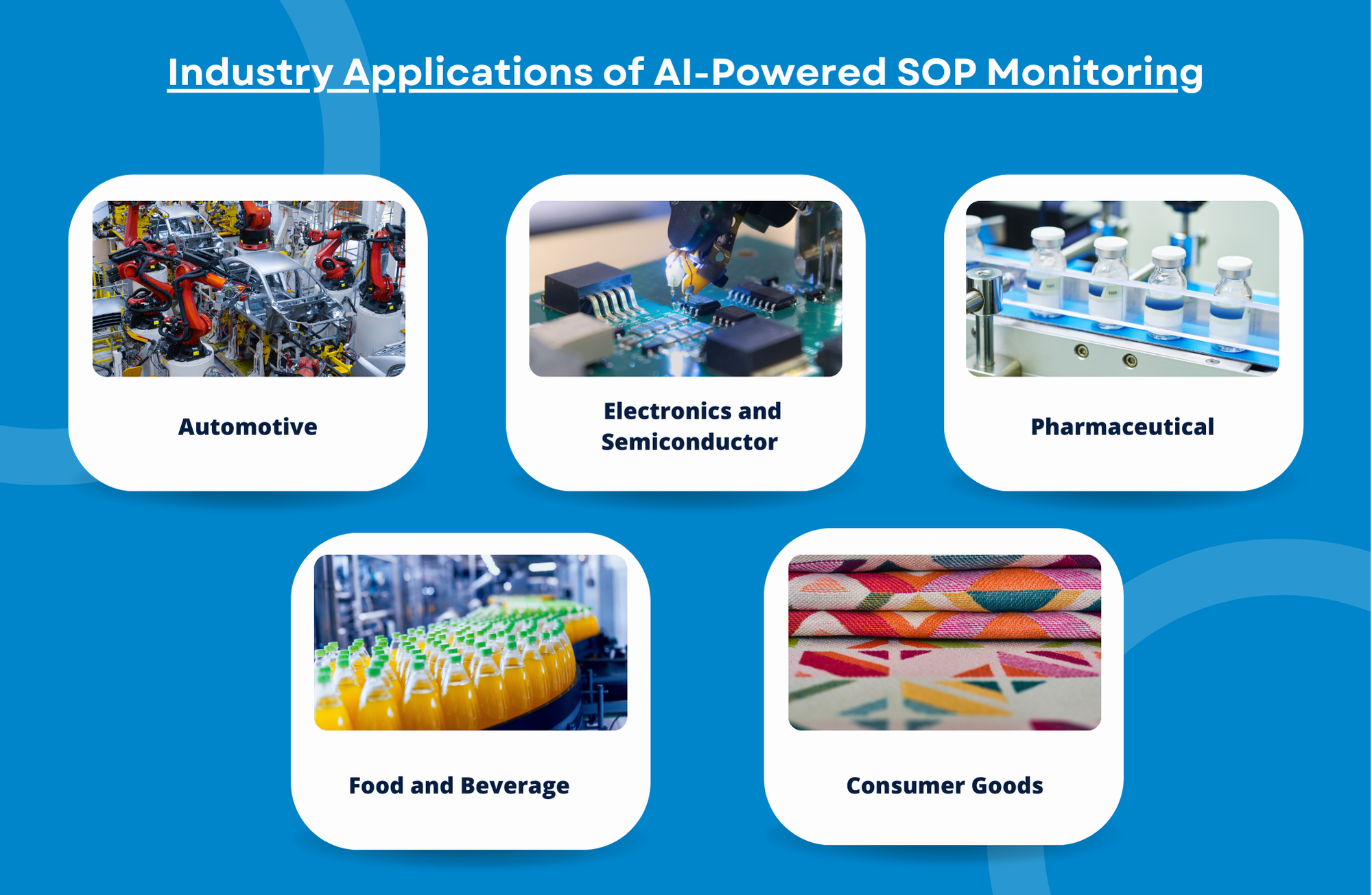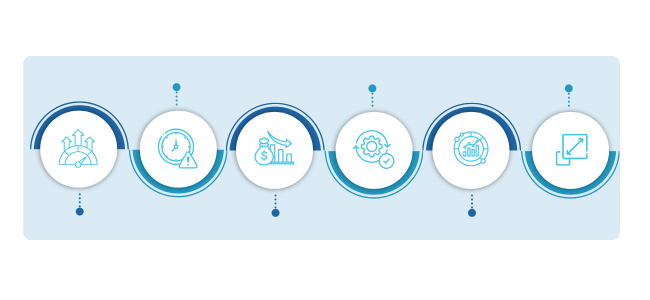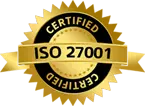SOP Monitoring in Manufacturing with AI-Powered Machine Vision Solutions
Published on: Jan 20, 2025

Written by: Content team, Intelgic
SOP Monitoring in Manufacturing with AI-Powered Machine Vision Solutions
In today’s fast-paced manufacturing landscape, ensuring product quality and adherence to standard operating procedures (SOPs) is crucial. With growing demands for precision, efficiency, and consistency, traditional monitoring methods are no longer sufficient. This is where AI-powered machine vision systems come into play. These systems are revolutionizing the way manufacturers monitor and maintain their production processes by automating SOP monitoring, step-by-step process tracking, and alerting teams in case of any deviation from established standards. In this article, we will explore the role of AI-powered machine vision systems in SOP monitoring, including the technologies used, workflow, applications across various industries, and the key benefits of automated SOP monitoring.

Understanding SOP Monitoring in Manufacturing
Standard Operating Procedures (SOPs) are documented guidelines that provide the best practices and instructions for performing tasks within the manufacturing environment. SOPs ensure that operations are carried out consistently and in compliance with regulatory standards. Monitoring these procedures is essential for maintaining product quality, safety, and overall operational efficiency.
In manufacturing, SOP monitoring refers to the process of tracking production activities to ensure that each step follows the predefined instructions. Deviations from SOPs can lead to defective products, safety hazards, and regulatory violations. Therefore, it is crucial to continuously monitor and enforce compliance with SOPs.
Importance of SOP Monitoring:
- Ensures Consistency: Guarantees uniformity and high-quality output.
- Maintains Quality: Detects deviations early to prevent defects.
- Regulatory Compliance: Ensures adherence to industry standards.
- Prevents Errors: Identifies issues early, reducing costly mistakes.
- Increases Productivity: Reduces downtime and improves workflow efficiency.
- Builds Customer Trust: Consistent quality fosters customer loyalty.
- Data-Driven Decisions: Provides actionable insights for optimization.
Technologies Driving SOP Monitoring in Manufacturing
AI-powered machine vision systems integrate cutting-edge technologies that facilitate the automated monitoring of SOP compliance. These systems leverage a combination of high-resolution imaging, deep learning algorithms, sensor networks, and real-time data processing to ensure that every stage of production adheres to the established guidelines. The core technologies include:
- Machine Vision Cameras: The backbone of any AI-powered monitoring system, the machine vision cameras capture high-definition images or videos of the production line in real-time. By strategically positioning these cameras, manufacturers can continuously monitor product dimensions, assembly quality, and even subtle surface imperfections that might otherwise go unnoticed.
- Deep Learning Algorithms: At the heart of AI-powered machine vision, deep learning models are trained to identify specific patterns, structures, and defects within the images captured by vision systems. These models analyze visual data against established SOP standards, identifying discrepancies with remarkable precision.
- Edge Computing: To process data efficiently and in real-time, AI models often run on edge devices located close to the production line. Edge computing reduces latency, ensuring that deviations are identified and alerts are triggered without delay, significantly minimizing the risk of defective products making their way down the line.
- Sensors and IoT Devices: Integrated sensors monitor critical environmental parameters such as temperature, pressure, humidity, and machine performance. These sensors provide supplementary data that, when combined with machine vision, offers a holistic view of the production environment, enhancing the accuracy of deviation detection.
- Data Analytics Platforms: Centralized platforms aggregate data from machine vision systems and sensors, offering advanced analytics capabilities. These platforms process historical data, identify trends, and generate actionable insights, helping manufacturers make data-driven decisions to optimize production workflows.
Real-Time Process Monitoring and Deviation Alerts
The operation of AI-powered machine vision systems for SOP monitoring revolves around continuous, step-by-step surveillance of the manufacturing process. Here’s an overview of how these systems function:
- Data Capture: The system continuously captures visual data from high-resolution cameras and records sensor readings. This data encompasses everything from product dimensions and assembly stages to environmental conditions.
- Data Processing and Analysis: Through deep learning models, the system processes the captured data, comparing it against predefined SOP standards. The AI algorithms have been trained on vast datasets and are adept at identifying even the slightest deviations from established norms.
- Deviation Detection: When discrepancies such as misaligned parts, incorrect assembly, or dimensional errors are identified, the system immediately flags the issue. This includes visual defects, incorrect assembly steps, or environmental variations that could affect product quality.
- Instant Alerts: Once a deviation is detected, the system triggers an immediate alert, notifying operators, quality control teams, and supervisors in real-time. These alerts can be delivered through a variety of communication channels, including mobile apps, email, or direct integration into enterprise resource planning (ERP) systems.
- Actionable Insights and Reporting: Alongside the alert, the system generates detailed reports that help production teams identify the root cause of the deviation. These reports include timestamps, location data, and visual evidence, enabling quick diagnosis and resolution.
- Continuous Monitoring and Adaptation: Machine vision systems are not static; they evolve over time. As more data is collected, the AI models refine their detection capabilities, becoming increasingly effective at identifying potential deviations and streamlining the monitoring process.
Optimizing Workflows Through AI-Driven SOP Monitoring
The implementation of AI-powered machine vision systems leads to a well-coordinated, automated workflow that integrates every aspect of SOP monitoring. Here’s an overview of how the typical workflow is structured:
- Pre-Production Configuration:
- The system is configured with the specific SOP guidelines for the production process.
- Machine vision cameras and sensors are strategically placed and calibrated to capture the necessary data points.
- Deep learning algorithms are trained using historical production data, ensuring the system can accurately identify deviations.
- Real-Time Production Monitoring:
- The system continuously observes the production process, capturing real-time data from cameras and sensors.
- Data is immediately processed and analyzed, checking for compliance with SOPs at every step of production.
- Deviation Detection:
- When an anomaly or deviation occurs, the system promptly identifies the issue, whether it’s related to product defects, dimensional errors, or environmental shifts.
- Alerts are sent out to notify relevant personnel of the issue.
- Root Cause Analysis and Resolution:
- The system provides detailed reports, enabling operators to quickly assess the nature and location of the problem.
- Corrective actions are taken to bring the process back in line with SOP requirements.
- Continuous Feedback Loop:
- The system continually updates its machine learning models based on new data, ensuring that future monitoring efforts are even more precise and effective.
Industry Applications of AI-Powered SOP Monitoring
AI-driven SOP monitoring systems have diverse applications across multiple industries. Below are a few key sectors that benefit from this transformative technology:
- Automotive Manufacturing: In the automotive sector, machine vision systems ensure that assembly processes adhere to the highest standards. From ensuring the correct installation of components to detecting surface imperfections, AI-powered systems guarantee that every vehicle meets stringent quality requirements.
- Electronics and Semiconductor Manufacturing: Machine vision is crucial in electronics manufacturing, where minute details—such as the placement of microchips and circuit boards—must be monitored. AI systems ensure precision, detecting defects that could compromise product functionality.
- Pharmaceutical Production: In the highly regulated pharmaceutical industry, SOP monitoring is vital to ensure compliance with FDA and other regulatory bodies. AI-driven systems monitor every stage of drug and device manufacturing, from packaging and labeling to the verification of correct dosages.
- Food and Beverage Processing: In food production, machine vision systems are used to monitor food safety, packaging integrity, and quality control. The technology helps detect contaminants, improper packaging, or labeling errors, ensuring products meet health and safety standards.
- Consumer Goods Manufacturing: For manufacturers producing goods such as textiles, apparel, and household products, machine vision systems ensure consistency in production and quality control. These systems track assembly processes, ensuring every product meets quality benchmarks.

The Benefits of Automated SOP Monitoring
AI-powered machine vision systems offer numerous advantages that far exceed traditional methods of SOP monitoring:
- Enhanced Accuracy: AI powered Machine Vision systems can detect even the smallest deviations with unmatched precision, ensuring that product quality and SOP compliance are maintained to the highest standards.
- Real-Time Alerts: Immediate alerts provide operators with the ability to address issues as soon as they arise, minimizing downtime and preventing defective products from progressing through the manufacturing process.
- Cost Efficiency: By automating SOP monitoring, manufacturers can reduce the reliance on manual inspections, cutting labor costs while simultaneously reducing the likelihood of costly errors.
- Consistency and Compliance: AI-driven monitoring ensures consistent adherence to SOPs across all production runs, regardless of shift changes or operator variability. This is particularly critical for maintaining compliance with industry regulations.
- Data-Driven Decision Making: The continuous flow of data offers manufacturers insights into production trends, process bottlenecks, and areas for improvement. These insights drive informed decision-making and operational enhancements.
- Scalability: As production lines grow and evolve, AI-powered systems seamlessly scale, handling increased monitoring demands without the need for significant infrastructure changes.

How Intelgic Stands Out in SOP Monitoring
Intelgic differentiates itself in SOP monitoring by offering a cutting-edge, AI-powered solution that seamlessly integrates machine vision, robotic automation, and IoT technologies to enhance manufacturing processes. Here’s how Intelgic stands out:
AI-Powered Machine Vision: Intelgic’s advanced AI algorithms detect deviations in real time, ensuring flawless compliance with SOPs and enhancing product quality.
IoT-Driven Monitoring: With IoT sensors, Intelgic continuously monitors critical parameters, enabling predictive maintenance and minimizing operational disruptions.
Instant Alerts & Analytics: Real-time alerts and powerful analytics empower quick corrective actions and data-driven decisions, improving overall productivity.
Scalability & Flexibility: Intelgic’s solution adapts to diverse industries and evolving production needs, offering customizable, scalable solutions.
User-Friendly Interface: The user-friendly platform ensures effortless integration into existing systems, minimizing training and maximizing efficiency.
Comprehensive Support: Intelgic provides end-to-end support, from implementation to ongoing optimization, ensuring continuous process improvement.
Conclusion
AI-powered machine vision systems are redefining the future of SOP monitoring in manufacturing. By automating the detection of deviations, providing instant alerts, and offering actionable insights, these systems ensure that manufacturers maintain product quality, reduce errors, and operate efficiently. From automotive and electronics to food production and pharmaceuticals, industries worldwide are benefitting from the precision and scalability of AI-driven SOP monitoring. As this technology continues to evolve, its potential to revolutionize manufacturing practices, enhance compliance, and streamline operations will only expand, cementing its role as a cornerstone of modern industrial automation.

